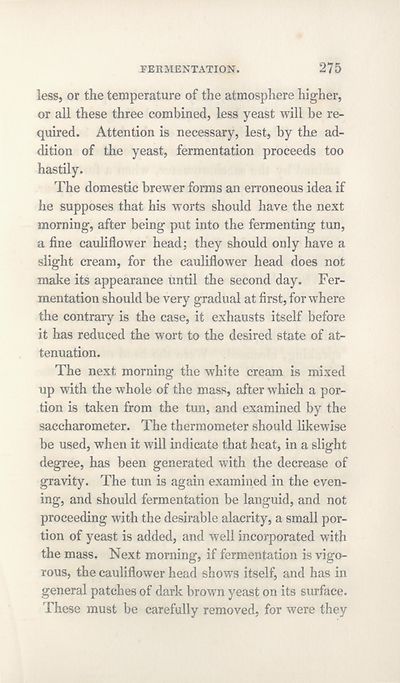Download files
Complete book:
Individual page:
Thumbnail gallery: Grid view | List view

FERMENTATION.
275
less, or the temperature of the atmosphere higher,
or all these three combined, less yeast will be re¬
quired. Attention is necessary, lest, by the ad¬
dition of the yeast, fermentation proceeds too
hastily.
The domestic brewer forms an erroneous idea if
he supposes that his worts should have the next
morning, after being put into the fermenting tun,
a fine cauliflower head; they should only have a
slight cream, for the cauliflower head does not
make its appearance until the second day. Fer¬
mentation should be very gradual at first, for where
the contrary is the case, it exhausts itself before
it has reduced the wort to the desired state of at¬
tenuation.
The next morning the white cream is mixed
up with the whole of the mass, after which a por¬
tion is taken from the tun, and examined by the
saccharometer. The thermometer should likewise
be used, when it will indicate that heat, in a slight
degree, has been generated with the decrease of
gravity. The tun is again examined in the even¬
ing, and should fermentation be languid, and not
proceeding with the desirable alacrity, a small por¬
tion of yeast is added, and well incorporated with
the mass. Next morning, if fermentation is vigo¬
rous, the cauliflower head shows itself, and has in
general patches of dark brown yeast on its surface.
These must be carefully removed, for were they
275
less, or the temperature of the atmosphere higher,
or all these three combined, less yeast will be re¬
quired. Attention is necessary, lest, by the ad¬
dition of the yeast, fermentation proceeds too
hastily.
The domestic brewer forms an erroneous idea if
he supposes that his worts should have the next
morning, after being put into the fermenting tun,
a fine cauliflower head; they should only have a
slight cream, for the cauliflower head does not
make its appearance until the second day. Fer¬
mentation should be very gradual at first, for where
the contrary is the case, it exhausts itself before
it has reduced the wort to the desired state of at¬
tenuation.
The next morning the white cream is mixed
up with the whole of the mass, after which a por¬
tion is taken from the tun, and examined by the
saccharometer. The thermometer should likewise
be used, when it will indicate that heat, in a slight
degree, has been generated with the decrease of
gravity. The tun is again examined in the even¬
ing, and should fermentation be languid, and not
proceeding with the desirable alacrity, a small por¬
tion of yeast is added, and well incorporated with
the mass. Next morning, if fermentation is vigo¬
rous, the cauliflower head shows itself, and has in
general patches of dark brown yeast on its surface.
These must be carefully removed, for were they
Set display mode to:
![]() Universal Viewer |
Universal Viewer | ![]() Mirador |
Large image | Transcription
Mirador |
Large image | Transcription
| Antiquarian books of Scotland > Occupations > British wine-maker, and domestic brewer > (313) |
|---|
| Permanent URL | https://digital.nls.uk/126003677 |
|---|
| Description | Thousands of printed books from the Antiquarian Books of Scotland collection which dates from 1641 to the 1980s. The collection consists of 14,800 books which were published in Scotland or have a Scottish connection, e.g. through the author, printer or owner. Subjects covered include sport, education, diseases, adventure, occupations, Jacobites, politics and religion. Among the 29 languages represented are English, Gaelic, Italian, French, Russian and Swedish. |
|---|

